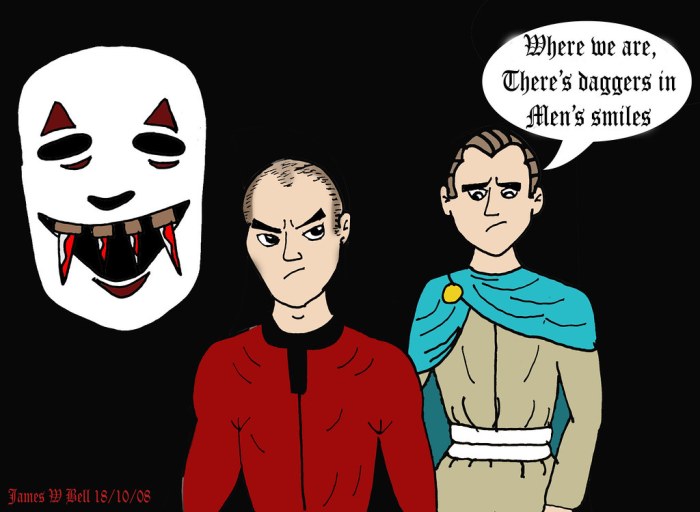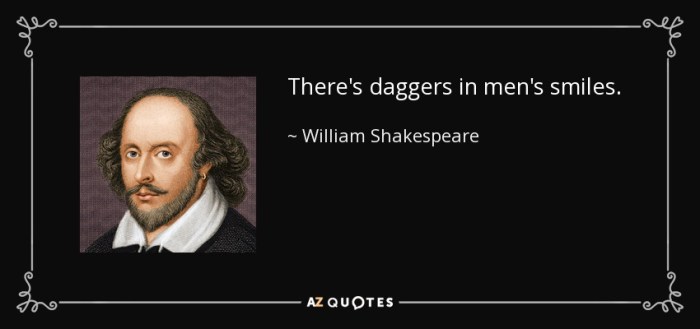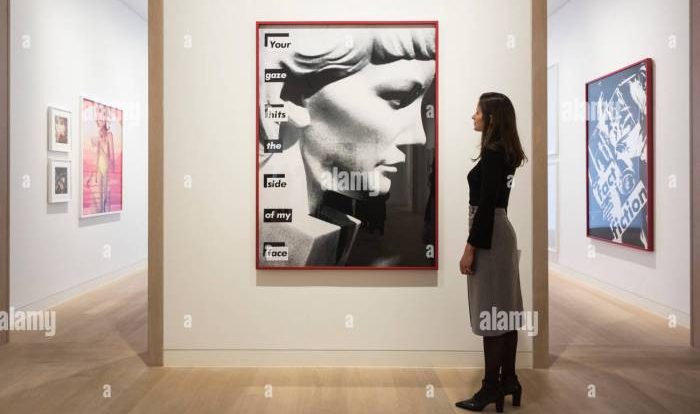In the realm of social interactions, the enigmatic phrase “there’s daggers in men’s smiles” captures the unsettling truth that smiles can often mask concealed hostility. This deceptive practice, where true intentions are hidden behind a veneer of friendliness, has profound implications for interpersonal relationships and the very nature of human communication.
This exploration delves into the psychological and social dynamics that underpin the use of smiles as a tool for deception, examining the motivations behind such behavior and the consequences of relying on smiles as an indicator of genuine emotions. Moreover, it emphasizes the importance of observing nonverbal cues and interpreting facial expressions to uncover hidden meanings, while acknowledging the challenges and limitations of relying solely on these cues for understanding intentions.
Hidden Malevolence in Social Interactions

Social interactions often involve a complex interplay of emotions, both positive and negative. While smiles are typically associated with joy, warmth, and friendliness, they can sometimes conceal hidden hostility or malevolence. The metaphor of “daggers in men’s smiles” aptly captures this duality, highlighting the potential for deception and danger lurking beneath a seemingly pleasant exterior.
Situations Where Smiles Mask True Intentions
There are numerous situations where smiles can mask true intentions. In competitive environments, for example, individuals may employ a “social smile” to gain an advantage over rivals. They may smile and appear amiable to disarm their opponents and create a false sense of trust.
Similarly, in social settings, people may smile to conform to social norms or to avoid appearing rude, even when they do not genuinely feel happy or positive.
Psychological Implications of Hiding Negative Emotions Behind a Facade
Hiding negative emotions behind a facade of smiles can have significant psychological implications. It can lead to emotional exhaustion, as individuals constantly suppress their true feelings. Over time, this suppression can contribute to mental health issues such as anxiety, depression, and burnout.
Additionally, it can damage relationships, as people may find it difficult to trust those who they perceive as being insincere or manipulative.
The Role of Deception in Social Dynamics

In social interactions, smiles play a multifaceted role, often serving as a form of nonverbal communication that conveys friendliness, warmth, and approachability. However, beneath the veneer of a smile, there can lie hidden depths, where deception and ulterior motives lurk.
Smiles as a Tool for Deception
Smiles can be employed as a deliberate strategy to mask true feelings, conceal negative intentions, or gain an advantage in social situations. By displaying a smile, individuals can create a facade of positivity and trustworthiness, even when their inner thoughts and emotions are far from benevolent.
Research has demonstrated that smiles can be used to deceive others about a person’s true emotional state. Studies have shown that individuals who are experiencing negative emotions, such as anger or sadness, are more likely to smile when interacting with others, particularly in situations where they perceive a need to maintain social harmony or avoid conflict.
Motivations for Hiding True Feelings Through Smiles
The motivations behind hiding true feelings through smiles are complex and can vary depending on the individual and the social context. Some common reasons include:
- Social conformity:Smiles are often perceived as a social norm, and individuals may feel pressure to conform to this expectation, even if they do not genuinely feel happy or positive.
- Fear of negative consequences:Hiding negative emotions through smiles can be a way to avoid social disapproval, criticism, or conflict. Individuals may fear that expressing their true feelings will lead to rejection or negative reactions from others.
- Personal gain:Smiles can be used strategically to gain an advantage in social interactions. By projecting a positive image, individuals may be more likely to be perceived as trustworthy, likable, and cooperative, which can lead to benefits such as increased social status or access to resources.
Consequences of Relying on Smiles as an Indicator of Genuine Emotions
Relying solely on smiles as an indicator of genuine emotions can lead to significant consequences. By assuming that a smile always reflects positive feelings, individuals may overlook or misinterpret underlying negative emotions or intentions. This can result in:
- Misunderstandings and miscommunication:Smiles can convey a range of emotions, including genuine happiness, social politeness, or even deception. Relying on smiles alone can lead to confusion and misinterpretations in social interactions.
- Increased vulnerability to manipulation:Individuals who are unaware of the deceptive potential of smiles may be more susceptible to manipulation by those who use smiles to conceal their true intentions.
- Diminished trust:Repeated exposure to deceptive smiles can erode trust in social interactions, making it more difficult to build genuine and meaningful connections.
In conclusion, smiles are a complex and multifaceted aspect of social interactions. While they can serve as a genuine expression of positive emotions, they can also be used as a tool for deception. Understanding the motivations behind deceptive smiles and the consequences of relying on them as an indicator of genuine emotions is crucial for navigating social dynamics effectively.
The Power of Observation and Interpretation

Observing nonverbal cues is crucial for uncovering hidden meanings in social interactions. Facial expressions, in particular, convey subtle nuances that can reveal a person’s true intentions. By understanding the significance of smiles and other facial cues, individuals can gain valuable insights into the thoughts and emotions of others.
Observing Facial Expressions
Smiling is a complex expression that can convey a wide range of emotions, from genuine happiness to forced politeness. To accurately interpret smiles, it is essential to consider the context of the situation and observe other nonverbal cues. A genuine smile typically involves a contraction of the muscles around the eyes, known as the “Duchenne smile.”
This involuntary response indicates true amusement or joy. In contrast, a forced smile involves only the muscles around the mouth and lacks the crinkling of the eyes.
Challenges and Limitations, There’s daggers in men’s smiles
While facial expressions provide valuable clues about a person’s intentions, it is important to acknowledge their limitations. Individuals can consciously control their facial expressions to deceive or conceal their true feelings. Additionally, cultural differences can influence the interpretation of facial expressions.
For example, in some cultures, smiling is considered a sign of respect, while in others it may indicate discomfort. Therefore, it is essential to combine the observation of facial expressions with other nonverbal cues and contextual factors to gain a comprehensive understanding of a person’s true intentions.
The Impact on Trust and Relationships: There’s Daggers In Men’s Smiles

The presence of ‘daggers in smiles’ can have a profound impact on trust in interpersonal relationships. When people feel that they cannot rely on the sincerity of others’ expressions, they become less likely to open up and share their true selves.
This can lead to a breakdown in communication and intimacy, as well as a general sense of mistrust and suspicion.
The consequences of being deceived by false smiles can be far-reaching. In some cases, it can lead to financial loss or even physical harm. In other cases, it can simply erode our faith in humanity and make it difficult to form meaningful connections with others.
Strategies for Building Trust in the Face of Potential Deception
Despite the challenges, there are a number of strategies that we can use to build trust in the face of potential deception. These include:
- Paying attention to non-verbal cues: Non-verbal cues, such as body language and facial expressions, can often reveal a person’s true intentions, even if their words do not.
- Being aware of our own biases: We all have biases that can make us more likely to trust certain people over others. It is important to be aware of these biases and to try to compensate for them.
- Giving people the benefit of the doubt: Sometimes, we may not be sure whether or not someone is being genuine. In these cases, it is often better to give them the benefit of the doubt and to see how things play out.
- Learning from our mistakes: If we have been deceived in the past, it is important to learn from our mistakes and to be more careful in the future. However, it is also important to remember that not everyone is out to deceive us, and that we should not become overly suspicious of others.
Cultural Variations in Smile Interpretation

The meaning of a smile can vary significantly across cultures. In some cultures, smiles are seen as a sign of happiness, while in others they may be interpreted as a sign of politeness, submission, or even deception. It is important to be aware of these cultural variations when interpreting facial expressions, as misinterpretations can lead to misunderstandings and communication problems.
Examples of Cultural Variations in Smile Interpretation
- In the United States, smiles are generally seen as a sign of happiness or friendliness. However, in some Asian cultures, smiles may be used to mask negative emotions, such as embarrassment or anger.
- In some Middle Eastern cultures, it is considered impolite to smile at someone of the opposite sex who is not a close friend or family member.
- In some African cultures, smiles are often used to show respect or deference to elders or superiors.
These are just a few examples of the many different ways that smiles can be interpreted across cultures. It is important to be aware of these variations when interacting with people from different cultures, as misinterpretations can lead to misunderstandings and communication problems.
Literary and Artistic Depictions

Throughout history, the theme of ‘daggers in smiles’ has been a prevalent motif in literature and art, capturing the deceptive nature of human interactions and the hidden malevolence that can lurk beneath a veneer of friendliness.
In literature, authors have used this imagery to explore the complexities of human relationships and the dangers of trusting appearances. William Shakespeare’s iconic play, Hamlet, features the character of Claudius, whose treacherous smile masks his true intentions of murdering his brother to seize the throne.
Similarly, in Nathaniel Hawthorne’s novel The Scarlet Letter, the character of Arthur Dimmesdale conceals his sinful past with a pious facade, his smile belying the guilt that torments him within.
In art, the depiction of ‘daggers in smiles’ has taken various forms. In the painting The Treachery of Imagesby René Magritte, a pipe is portrayed with the inscription “Ceci n’est pas une pipe” (“This is not a pipe”), highlighting the disconnect between appearance and reality.
Similarly, the sculpture The Veiled Ladyby Raffaello Monti depicts a woman with a delicate veil covering her face, suggesting the hidden emotions and secrets that lie beneath the surface.
These literary and artistic depictions serve as powerful reminders of the potential for deception in social interactions and the importance of critical thinking and discernment in forming judgments about others.
Examples of Famous Works
- Hamletby William Shakespeare
- The Scarlet Letterby Nathaniel Hawthorne
- The Treachery of Imagesby René Magritte
- The Veiled Ladyby Raffaello Monti
Symbolism and Significance
The symbolism of ‘daggers in smiles’ in literature and art underscores the following aspects of the human condition:
- Deception and Betrayal:The image of a smile concealing a dagger represents the betrayal of trust and the deceptive nature of human interactions.
- Inner Conflict and Hypocrisy:The hidden daggers symbolize the internal struggles and hypocrisy that can exist within individuals, as they attempt to maintain a facade of respectability.
- The Danger of Appearances:These depictions remind us that appearances can be deceiving and that we should not judge others solely based on their outward demeanor.
By exploring the theme of ‘daggers in smiles,’ literature and art provide a cautionary tale about the complexities of human nature and the importance of vigilance and skepticism in social interactions.
Top FAQs
What is the significance of “daggers” as a metaphor in this context?
The metaphor of “daggers” represents the concealed hostility or malicious intent that can lie beneath a smile.
How can smiles be used as a tool for deception?
Smiles can be used to mask true feelings, create a false sense of trust, or manipulate others into believing something that is not true.
What are the challenges of relying solely on facial expressions for understanding intentions?
Facial expressions can be ambiguous and can vary depending on cultural context, making it difficult to accurately interpret intentions based solely on facial cues.
